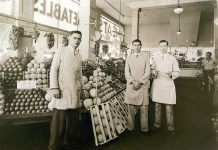— Rollie Atkinson
A hundred wineries hosted thousands of Barrel Tasting visitors
last weekend to give a big mid-winter boost to our multi-million
dollar wine industry. Almost everyone went home happy except for a
few winery neighbors left to complain about the traffic and the
sometimes overly gleeful winelovers.
Well, this is Wine Country isn’t it? And can two weekends of
extra traffic and fun-making really be a problem in the middle of a
downcast economy? Sonoma County’s wine industry grew up a long time
ago and all of us — from old-timers to newcomers — now share a
world-famous address. If we don’t grow winegrapes or do business
with a winery then we know someone who does. And many more of us —
if not all of us — owe a portion of our livelihood, tax base and
prestige — to this agricultural industry we sometimes love to
hate.
For 32 years now, the first weekend in March has meant Barrel
Tasting along the Russian River Wine Road. In 1978, the first year
of the event, just 18 wineries participated. The event is now
spread over two weekends and 130 wineries are opening their cellar
rooms to winelovers of many ages and from many places near and far.
The Wine Road sold 18,500 advance tickets and expects another
12,000 visitors this coming weekend. Over half of last weekend’s
visitors came from places outside of California, according to Wine
Road Executive Director Beth Costa. “These people want to build a
relationship with the winemakers and owners,” she said. “Even the
youngest visitors don’t just want to buy wine at a grocery store.
It’s more than a bottle on a shelf to them. It’s the whole
experience.”
The world of wine has always been that way. It’s all about the
romance, fermented mysteries, palette-pleasing poetry and bottled
lore for the thousands of Barrel Tasting wine enthusiasts. For some
of us that get caught in the traffic and crowds it’s just a lot of
noise, imbibing and excess. Like just about everything in life, you
have to take the bad with the good.
Sonoma County’s winegrape crop totalled $461 million last year.
That equals half of the county’s total agricultural production that
also includes dairy, poultry, apples, nursery stock and farm market
vegetables and produce. More than 50,000 acres of vineyards have
been planted in Sonoma County, almost doubling vine plantings since
1990. No wonder this place we used to call the Redwood Empire is
now called Wine Country.
With all that comes a Wine Country lifestyle. We know about it
because we read it in the New York Times, Gourmet and Martha
Stewart’s magazine. When thousands of weekend and festival visitors
descend on us then Wine Country has become too popular. But when we
want a world-class dining experience, a neighborhood winetasting
affair or a fancy fund raiser we think differently.
Here in Sonoma County’s wine country some of our town squares
are ringed with too many winetasting rooms, according to some.
Elsewhere, our narrow country roads get overloaded with
winetasters, weekend tourists, bicyclists and stretch limos. New
wineries keep popping up at every crossroad, or so it seems. Apple
orchards, cow pastures and open hills are being converted to
vineyards. We raise concerns about erosion, habitat and stream
protection and depletion of our water table.
For us who have the “up close and personal” view of Wine
Country, we know about the changed landscape, extra traffic and
increased demands on our natural resources and unspoiled views that
go into the poetry of winemaking and the lure of its celebrated
lifestyle.
We could ponder how things might be otherwise. Relaxing around a
table of local artisan cheeses, locally-baked breads, olives,
antipasto and a Russian River Valley pinot noir, Dry Creek
zinfandel or a ripe chardonnay, we could conjecture what life might
be like if our dominant industry was coal mining, steel refineries
or hog farm factories. Cheers.








